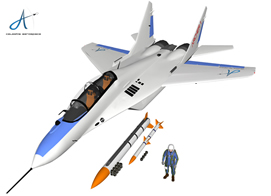The Spanish company is putting in place a manufacturing and launch service for small satellites using a MiG-29 combat aircraft as the means of putting them into orbit. The firm operates from an airport located in Spain.
Celestia Aerospace will design and build these satellites, launch them into space and be responsible for their data management. The satellites will be manufactured according to customer requirements; shaped like cubes measuring 10cm per side, they will weigh about 10kg.
The advantage of this new satellite is the low cost—launching them will cost only about €50,000—compared to conventional systems. The satellites could be used for communications, zero gravity experiments, orbital photography and certification of electronic and mechanical components for larger satellites.
Nanosatellites placed into orbit have the ability to send data they collect back to an Earth tracking station. At an airfield, the company will build a hangar where a missile containing the satellites to be launched can be attached to the MiG-29 fighter aircraft. The first launches are expected to take place in early 2016.
The MiG-29 is a high performance and reasonably priced fighter plane. Their moderate cost of about €5 million each makes this launching system viable.
Celestia plans to launch two satellites called the BioPharmaSAT, aimed at the biotechnology sector, and the SemicondSAT, which targets the electronics sector. They will act as test beds for new materials and high technology material processes in zero gravity environments. This could include the crystallization of proteins and high technology materials, which are important areas of study for the pharmaceutical and semiconductor industries, respectively.
